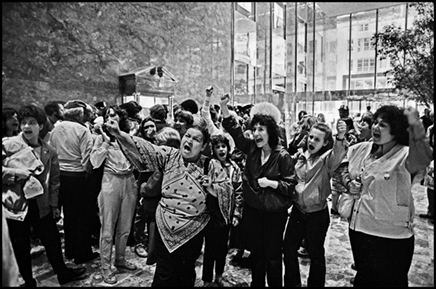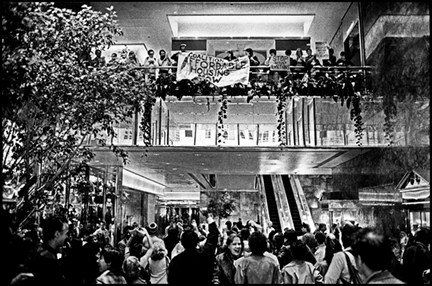
George Cohen
May 4, 1985 inside Trump Tower.
More than thirty years ago, New York City neighborhood housing advocates embarked on a rousing public campaign to expose the enormous inequities in city housing and tax policies.
Then as now, they were battling programs that granted fat tax breaks to luxury development while shortchanging affordable housing.
And then as now, many of the culprits were the same.
The activists decided to kick off the effort with a noisy demonstration through Manhattan streets. Their destination was the city’s most infamous symbol of tax-subsidized gluttony: Trump Tower.
Donald Trump had just won a tax abatement worth $20 million for his glitzy 58-story condo palace at Fifth Avenue and 57th Street, next door to Tiffany & Co. He had also won permission to add more than 100,000 square feet to the building by agreeing to maintain public space in his marble-walled five-story atrium which he filled with high end retailers and a large stone waterfall.
On the morning of May 4, 1985, marchers assembled in Chelsea, then paraded east to Fifth Avenue. After a rally in front of Trump’s palace, a large group of demonstrators swarmed into the lobby, many riding the escalator to the balcony where they unfurled their banners over a railing.

George Cohen
The tension banner is unfurled near the now infamous escalator.
It was the same escalator on which Trump descended to announce his presidential candidacy last year, the same lobby from which he denounced immigrants as “rapists” and “criminals,” creating a firestorm that still rages.
Galen Kirkland, then a young lawyer from Harlem helping to spearhead the campaign, recalled what happened next.
“First the Trump guards came and tried to push us out; then the police were summoned. I was standing there in the midst of everything and this police officer came up and said, ‘You know, you have to leave.’ I said, “Why? This is public space. We have a right to be here, a right to peaceful assembly.'”
As demonstrators cheered from the balcony above and tourists gawked, Kirkland stood his ground in the lobby. “It was a stand-off. We didn’t know where this was going to go. But we were not disorderly. We weren’t being violent. We were just using our voices to denounce this tax abatement granted to Trump for no value.”
Eventually, as more police arrived, the activists slowly moved out of the palatial lobby as shoppers and news cameras snapped photos.

George Cohen
Kirkland stands his ground.
Kirkland, still a leader in the Harlem community working on educational issues, recalls every minute of the demonstration with pride and satisfaction.
“I remember it with great fondness. We had a housing justice movement. It was very empowering. It was a moment where people believed in their own power and were fighting back.”
As for Trump, Kirkland said, there was little doubt back then about what he represented. “It was clear from his record: He was a ruthless developer. He has somehow managed to go from a single-minded developer without a conscience to a champion of the people. He’s an example of brilliant marketing.”








